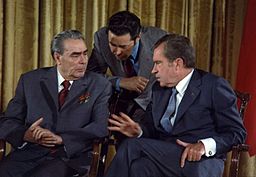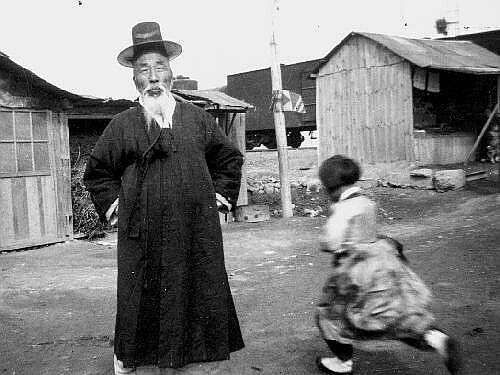Support Any Friend, Oppose Any Foe
Although she was not seated prominently on the rostrum beside new first lady Jacqueline Kennedy and her past and future peers Lady Bird Johnson, Mamie Eisenhower, and a disagreeable-looking Pat Nixon, Eleanor Roosevelt was in attendance when John F. Kennedy took the oath of office. On that frigid January morning in 1961, JFK’s breath was billowing visibly from his mouth as he implored his fellow Americans to “Ask not what your country can do for you. Ask what you can do for your country.” She would ride past the president on the reviewing stand in the inaugural parade with fellow representative of America’s war years Edith Wilson, Woodrow’s eighty-eight year-old widow, and later write to Kennedy of the “sense of liberation and lift to the spirit” she had experienced during his address.
Six weeks later, President Kennedy hosted Eleanor at the White House on the day he issued the Executive Order making the Peace Corps a reality. She was thankful for the opportunity to “have a glimpse of the children…and of the lovely redecorating that you are doing,” adding that “with all the responsibilities and aggravations that are bound to come your way, it does make a difference if one’s surroundings are pleasant and cheerful.” Kennedy outlined for her the agency’s systemic particulars and stressed how vital public service among the nation’s youth was to the success of his policies and to their own best interests. The Advisory Council for the Peace Corps would be one of several pro-active brain trusts (others including Tractors For Freedom, George McGovern’s Food For Peace, the President’s Commission on the Status of Women, as well as the Cancer Foundation bearing her name) to which Eleanor would contribute during the twenty months of earthly existence left to her.
I Might Be of Use
Appointed in 1945 by President Harry Truman to the first American delegation to the United Nations, Eleanor Roosevelt was unanimously elected to chair the newly formed Commission on Human Rights. Before magnanimously stepping down from the position in 1951 (then forcibly resigning from the UN altogether a year later, per President Eisenhower’s request), Eleanor was the driving force behind the drafting and passage of the Universal Declaration of Human Rights, still considered, nearly seventy years later, a monumental achievement.
Kennedy, at the urging of UN Ambassador Adlai Stevenson, reinstated her to the General Assembly just before the official formation of the Peace Corps. She sat in on plenary meetings, consulted with international delegates, traveled the globe extensively on productive good will missions, and used the My Day column to proliferate her message from the exclusivity of private chambers out into the court of public opinion.
In July 1961, with the physical, moral, and ideological wounds sustained by African Americans in Alabama and Mississippi during the Freedom Rides still very fresh, a bulk mailing was sent out across the country with the endorsement of Harry Belafonte, including one addressed directly to President John F. Kennedy in care of the White House, soliciting donations for CORE, or Congress of Racial Equality. Among their esteemed advisory committee were the likes of Reverend Ralph Abernathy, novelist James Baldwin, Jackie Robinson, FDR’s main civil rights critic A. Philip Randolph, and Martin Luther King Jr. Eleanor contributed a note inside each envelope which beseeched that “you and I keep faith with those who suffered” and demanded the continuation of vigilant activity “until buses and terminal facilities are open to all - everywhere - in our country.”
She personally appealed to Kennedy for mercy in the case of fifteen year-old Preston Cobb Jr., a black Georgian found guilty and condemned to death for the murder of a seventy year-old white farmer. Though Cobb admitted in an unsworn statement to having shot Frank Coleman Dumas to death, Eleanor branded “unthinkable” the County Superior Court’s eye-for-an-eye retribution against “a boy of fifteen, whether black or white.”
She also petitioned the president on behalf of convicted Communist Junius Scales who, after weighing the facts of his case, Eleanor believed was “deserving of compassion”, determining that “in a democracy, the fate of an individual is important”.
You Can Take the Boy Out of Boston…
Kennedy’s elocution, and the general delivery of his speeches, which could be mistaken by some for condescension, caused Eleanor to remark that his public addresses would never “take the place of fireside chats”, FDR’s famous form of communication while he was in the White House. As for his harsh Boston accent, which she wished he would “deepen and strengthen” to convey more sincere “strength and personality”, Jack could only volley back light-heartedly, “It is difficult to change nature, but I will attempt to nudge it.” In the very next sentence he mirrors Eleanor’s somber concern over the nuclear arms race with the Soviets in which there could be no winner. “It would be possible to be among the dead rather than the quick,” he wrote. “This has been the weapon on which we have relied for our security…we are going to attempt to improve this, however.”
In light of this, it seems a bit ironic that Eleanor would forward to President Kennedy, “with every good wish and apologies for the number of things I keep sending your way”, the January 1962 issue of Computers and Automation. The cover story was a report on the advancements made to military weapons capabilities called Computers and War Safety Control, which she hoped would be of use to Kennedy and the scientific community in beating their Soviet counterparts to the atomic punch.
This Great Society of Ours
In recognition of her numerous global humanitarian endeavors, President Kennedy sent a letter to the Nobel selection committee nominating Eleanor Roosevelt for 1962’s Nobel Peace Prize. “I am grateful for your kindness,” she humbly wrote to him, “but shall not be surprised if nothing comes of it.” Unfortunately, nothing did. The golden medallion went instead to molecular biologist Linus Pauling who had previously won the Nobel Prize for Chemistry in 1954.
Kennedy was the special guest on Eleanor’s Prospects of Mankind program, broadcast in April 1962 on WGBH, Boston’s public television affiliate. Discussing their joint venture, the Committee on the Status of Women, the president opined that “providing equal pay and equal conditions for women” was a “matter of great national concern”. After acknowledging the sincerity of his sentiments, Eleanor laments the dichotomy of the situation in relation to foreign nations wherein “women can be found in higher positions, policy-making positions or legislative decisions than they are in this country.” A recurring theme of the president’s boys’ club mentality throughout the interview centered around “how a mother can meet her responsibilities to her children and at the same time contribute to society.” To prove his commitment to the cause, Kennedy, just weeks later, joined Eleanor for the International Ladies’ Garment Workers’ Union Housing Project dedication in New York City.
These Particularly Difficult Days
In mid-June, with the Cold War heating up daily by calculable degrees, Kennedy responded to Eleanor’s despair in regard to National Security Advisor McGeorge Bundy’s proposal to conduct high altitude nuclear testing, recognizing “an apparent contradiction between our efforts to advance the peaceful uses of outer space at the UN and experiments like these.”
Unwell yet unwavering, Eleanor dictated a September 27 letter to President Kennedy asking for the use of his name as Honorary Chairman of the Wiltwyck School for Boys, “a unique residential treatment center for deprived, neglected, and disturbed children all under the age of twelve” of which she was a founder and member of its Board of Directors. Five days later, Eleanor mailed Kennedy a typed thank you note for the flowers he sent, along with the cryptic disclosure that “the cause of my fever has been discovered” above her alarmingly shaky signature. The unspecified “cause” was bone marrow tuberculosis.
The handwritten note Eleanor received from Kennedy for her 78th birthday would sadly conclude their personal correspondence. She passed away in her Manhattan apartment on November 7, 1962. An Executive Order issued the following day decreed that, until her internment, flags of all buildings, grounds, embassies, legations, consular offices, military facilities and vessels be flown at half-mast. Mary Todd Lincoln was the only other first lady up to that point to be accorded such a distinctive honor, and only then because of her husband’s extraordinary achievements.
Typically defiant, even while staring into the grim face of her own mortality, Eleanor expressed her desire for her public farewell to be quiet and intimate, a wish which even she must have known on some level was absurd and would be disregarded. She was laid to rest on November 10 beside Franklin in Hyde Park, New York in what was tantamount to a state funeral, attended by her dear old friend Adlai Stevenson, Supreme Court Chief Justice Earl Warren, New York Governor Nelson Rockefeller, Secretary of State Dean Rusk, former Presidents Harry Truman and Dwight Eisenhower alongside Bess and Mamie, and Vice President Lyndon Johnson with Lady Bird.
John and Jackie Kennedy arrived on the first flight made by the new Air Force One, the very same plane that would, not much more than a year later, convey the body of the assassinated President Kennedy back to Washington from Dallas and on which Lyndon B. Johnson would assume command of the mourning nation as Jackie stood boldly by his side in her blood-spattered pink suit.
In a statement issued on October 11, 1963, Kennedy (as both President of the United States and Chairman of the Eleanor Roosevelt Memorial Foundation) celebrated what would have been her 79th birthday with the release of the Eleanor Roosevelt commemorative stamp.
“Her memory serves as an abiding reminder of the ideals of which she provided the most complete embodiment among Americans of this age,” declared Kennedy. “The ideals of justice, of compassion, and of hope.”
Did you enjoy this article? If so, tell the world! Tweet about it, like it or share it by clicking on one of the buttons below!
And remember, you can read Chris’ article on JFK and Roosevelt in the 1950s here, and his article on 1960 election between Nixon and Kennedy here.
















